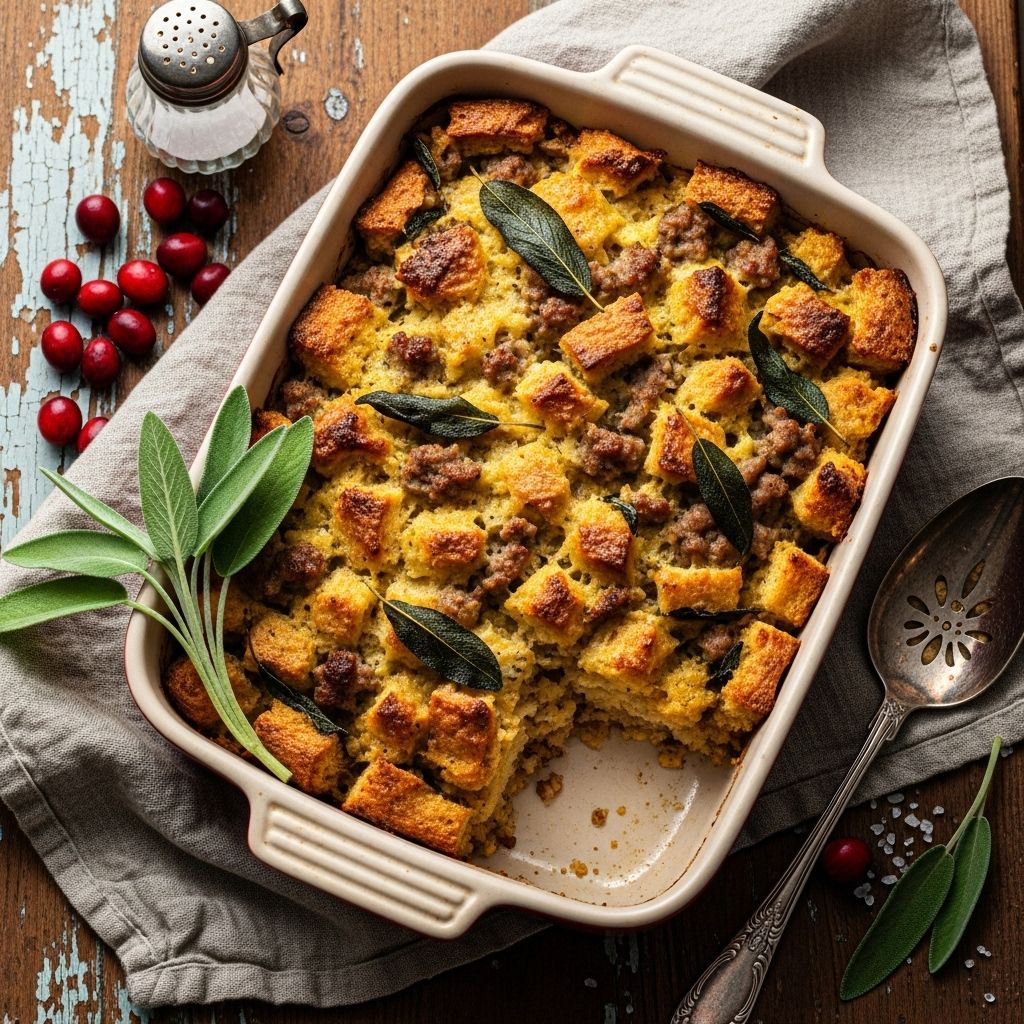The Ultimate Guide to Classic Sage and Sausage Stuffing
Every mouthful offers a fluffy crumb, rich herbs, and a satisfying golden crust.

Classic Sage and Sausage Stuffing: The Ultimate Guide
Sage and sausage stuffing is a beloved staple of the American holiday table, prized for its deeply savory flavor, aromatic herbs, and hearty texture. Whether you call it stuffing (when cooked inside a bird) or dressing (when baked separately), this guide covers everything you need to know to make it perfectly every time, from ingredient choices to step-by-step preparation and frequently asked questions.
What Makes Classic Stuffing So Special?
The classic sage and sausage stuffing stands out for its combination of rustic bread, flavorful pork sausage, and a mix of fresh herbs—most notably sage. This dish brings together textures and aromas that encapsulate the spirit of holiday comfort food.
Key Ingredients: Building Flavor and Structure
- Bread: Rustic, hearty white bread or sandwich bread, thoroughly dried or staled, forms the backbone and soaks up savory flavors.
- Pork Sausage: Choose fresh breakfast or sage-flavored sausage, high in fat to provide richness. Vegan sausage can substitute if needed.
- Fresh Sage: Essential for earthy, fragrant notes; combined with parsley and sometimes thyme for depth.
- Onion and Celery: Provide sweetness and crunch, forming the aromatic base.
- Garlic: Adds subtle pungency and rounds out the flavor.
- Butter: Enriches the stuffing and enhances overall texture.
- Eggs: Help bind the mixture, giving it a luscious, bread pudding-like consistency.
- Poultry or Chicken Stock: Moistens the bread, infusing it with additional flavor.
Preparing the Bread: Stale vs. Dried
Bread preparation is crucial for good stuffing. The bread needs to absorb flavorful liquids without disintegrating:
- Staling happens as bread sits out and loses freshness, but doesn’t necessarily mean it’s dry enough.
- Drying is best done by cutting the bread into cubes, spreading them on baking sheets, and dehydrating in a low oven (around 250°F/120°C for 30-45 minutes). Dry bread absorbs stock more evenly and produces better texture.
Step-by-Step: How to Make Classic Sage and Sausage Stuffing
- Dry the Bread: Cut bread into 3/4-inch cubes and dry in the oven until crisp and moisture-free. Let cool in a large bowl.
- Cook the Sausage: In a large Dutch oven or skillet over medium-high heat, melt butter. Add bulk sausage and break it up with a potato masher or spoon. Cook until crumbled and no longer pink, about 8 minutes.
- Add Aromatics: Stir in chopped onions, diced celery, minced garlic, and chopped sage. Sauté until vegetables are soft (about 10 minutes).
- Combine Ingredients: Remove pan from heat. Scrape the sausage mixture over the dried bread.
- Mix Wet Ingredients: In a bowl, whisk eggs with chopped parsley and poultry or chicken stock until thoroughly combined.
- Moisten the Bread: Pour the egg and broth mixture evenly over the bread and sausage. Gently fold with a spatula to coat all the pieces; the bread should be very moist but not swimming in liquid.
- Let Rest: Let mixture sit for 5-10 minutes to ensure absorption.
- Season and Taste: Taste a small piece and adjust salt and pepper as needed.
- Transfer and Bake: Spoon the mixture into a greased baking dish. Compress gently to fit, then cover with foil.
- Bake: Bake at 350°F (175°C) for 30 minutes covered. Remove foil and continue baking another 15-25 minutes until the top is golden and crisp.
Tips for the Best Results
- Don’t Overmix: Fold ingredients gently to retain a fluffy texture.
- Control Moisture: Aim for saturated but not soggy bread. Add extra broth if the mixture looks dry during baking.
- Flavor Flexibility: Try additional herbs like thyme or marjoram for variation, but sage should remain dominant for classic flavor.
- Vegan/Vegetarian Adaptation: Use plant-based sausage and replace eggs with a binder like flaxseed meal mixed with water. Vegetable broth can be substituted for poultry stock.
Sausage Selection: Pork and Beyond
For traditional flavor, use crumbly, high-fat breakfast sausage, ideally sage-flavored pork sausage. Avoid precooked sausage links, as you want the raw meat to render flavor into the stuffing. If desired, vegan alternatives (like seasoned plant-based sausage) work well and can replicate the meaty texture and seasoning.
Classic Herb Profile: Sage Leads the Way
The classic stuffing depends on a blend of fresh sage and parsley. Sage brings a peppery, piney aroma, while parsley brightens the profile and supports the savory base. Small amounts of thyme, marjoram, or rosemary can be added, but remember, sage should remain the star.
Moisture Levels: Creating the Perfect Texture
The goal is a moist stuffing—not dry cubes and not mush. Eggs bind the mixture for a custardy interior, while a good amount of broth ensures bread pieces become creamy yet hold their shape. For a richer dish, use turkey or chicken broth and even a splash of cream if preferred.
Frequently Asked Questions (FAQs)
Should I use stuffing or dressing?
Both terms refer to essentially the same dish. “Stuffing” is typically cooked inside poultry, while “dressing” is baked separately. Baking outside the bird is safer and delivers a better-crusted top.
Can I make stuffing ahead of time?
Yes. Prepare everything up to baking, then store tightly covered in the fridge for up to a day. Bake right before serving. For leftovers, reheat covered with foil to retain moisture.
Can I use store-bought bread cubes?
While homemade dried bread offers the best texture and flavor, plain store-bought bread cubes can be used in a pinch. Avoid seasoned and overly soft varieties for the most consistent results.
Is it possible to make a gluten-free version?
Yes. Use your favorite gluten-free, sturdy sandwich bread, dried thoroughly before use. The results are very similar to classic versions when properly prepared.
Can the eggs be omitted?
Eggs help provide structure and a custardy consistency. For egg-free versions, substitute with a “flax egg” or leave out entirely; just reduce the amount of liquid slightly and be aware the final stuffing will be less cohesive.
Ingredient Table: Classic Sage and Sausage Stuffing
| Ingredient | Recommended Amount | Substitutions/Notes |
|---|---|---|
| Bread (white, rustic) | 1 loaf (~1.5 lbs), cubed and dried | Sourdough or whole wheat work too |
| Pork sausage (bulk, raw) | 1.5 lbs | Vegan sausage for plant-based |
| Unsalted butter | 1 stick (8 tbsp) | Olive oil for dairy-free |
| Yellow onion | 1 large, diced | Shallots can substitute |
| Celery | 4 ribs, diced | Fennel bulb for variation |
| Garlic cloves | 2, minced | May omit if desired |
| Fresh sage | 1/4 cup, minced | 2-3 tbsp dried sage if fresh unavailable |
| Fresh parsley | 1/4 cup, chopped | Dried parsley can be used |
| Eggs | 3 large | Omit or use egg alternative as needed |
| Chicken or turkey stock | 2 cups | Vegetable broth works too |
| Salt & pepper | To taste | Season at several stages |
Variations and Customizations
- Herb Blends: Add thyme, marjoram, or rosemary for nuanced flavor.
- Add-ins: For texture and bursts of sweetness, mix in diced apples, dried cranberries, or toasted nuts.
- For a crispier top: Drizzle melted butter over the surface before the final round of baking uncovered.
- Spicier version: Use hot Italian sausage or a pinch of chili flakes.
Serving Suggestions
- Pair with roast turkey, chicken, or pork. Stuffing is a natural match for roast fowl, but it’s equally delicious with pork loin or chops.
- Gravy ready: A spoonful of classic turkey or chicken gravy takes this stuffing over the top.
- Make it a main: Serve as a centerpiece for a vegetarian feast by using rich vegetable stock and plant-based sausage.
Baking and Storage Tips
- Leftovers keep well for up to 3 days, tightly wrapped in the refrigerator.
- Reheating is best in the oven, covered with foil at 350°F to restore moisture and crisp the top.
- Freezing is possible: Freeze assembled (unbaked) or baked stuffing for up to 1 month. Thaw overnight in the fridge and bake until hot through.
More Stuffing FAQs
Do I have to toast the bread if it’s already stale?
Stale bread alone doesn’t always mean it’s dry enough. Toasting ensures uniform dryness, which leads to better texture and flavor absorption.
What is the best way to break up sausage in the pan?
A potato masher breaks up sausage quickly into fine crumbles, speeding even cooking and distribution in the stuffing.
What should the stuffing consistency be before baking?
The mixture should feel moist and slightly squishy, with bread cubes saturated but still holding their shape. Adjust broth as needed before baking.
How can I prevent soggy stuffing?
Dry bread, careful measurement of liquid, and baking uncovered for the final part of cooking help keep the stuffing from becoming mushy.
Conclusion: The Heart of the Holiday Table
This classic sage and sausage stuffing recipe offers a deeply satisfying, savory side that sits at the heart of the holiday meal. By selecting quality ingredients, ensuring well-dried bread, and seasoning generously, you can make stuffing that will become a tradition at your table year after year.
References
Read full bio of Srija Burman












